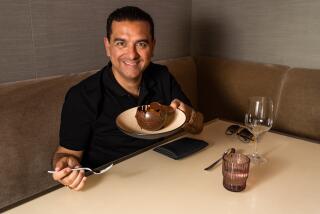Among dessert chefs, there are two philosophical...
- Share via
Among dessert chefs, there are two philosophical schools that, in the most simplistic sense, come down to style versus substance.
On one side, there are the gravity-defying desserts that are late-20th-century descendants of the architected creations that France’s Care^me did for Talleyrand at the start of the 19th century. They are lovely to look at, not always so lovely to eat.
On the other side, there are the simpler, sometimes rustic-looking desserts that most often rely on seasonal fruit for their incredible flavors.
“Grande Finales: A Modernist View of Plated Desserts” by Timothy Moriarty and Tish Boyle (Van Nostrand Reinhold, $49.95) unabashedly comes down on the side of style, while insisting that great flavor is achievable too. But flavor is not first in the minds of the chefs who created the astonishing desserts photographed by John Uher like the sculptures many of them are.
At first look, Jacques Torres, pastry chef at Le Cirque 2000 and star of the new PBS series “Dessert Circus With Jacques Torres,” appears to be purely a style guy. His TV series companion book, “Dessert Circus” (Morrow, $28), is full of spun sugar creations and chocolate assemblages--consider “The Mask” with red spun sugar Bozo hair and a hat made of kiwis--that feed the fantasy of what many people think a dessert chef creates.
But Torres has a quieter side too. His grape clafoutis is a nice take on the classic cherry dessert, and he makes a “mimosa aspic” that shows off the flavor of tangerines and, even better, a simple roasted pineapple scented with vanilla beans.
Classic dessert collectors should note that the book also includes the recipe for the creme bru^lee that Le Cirque made famous--even ubiquitous, if you believe that previous Le Cirque pastry chef Dieter Schorner originated the dessert that spawned a thousand passion fruit spinoffs.
More to Read
Eat your way across L.A.
Get our weekly Tasting Notes newsletter for reviews, news and more.
You may occasionally receive promotional content from the Los Angeles Times.










